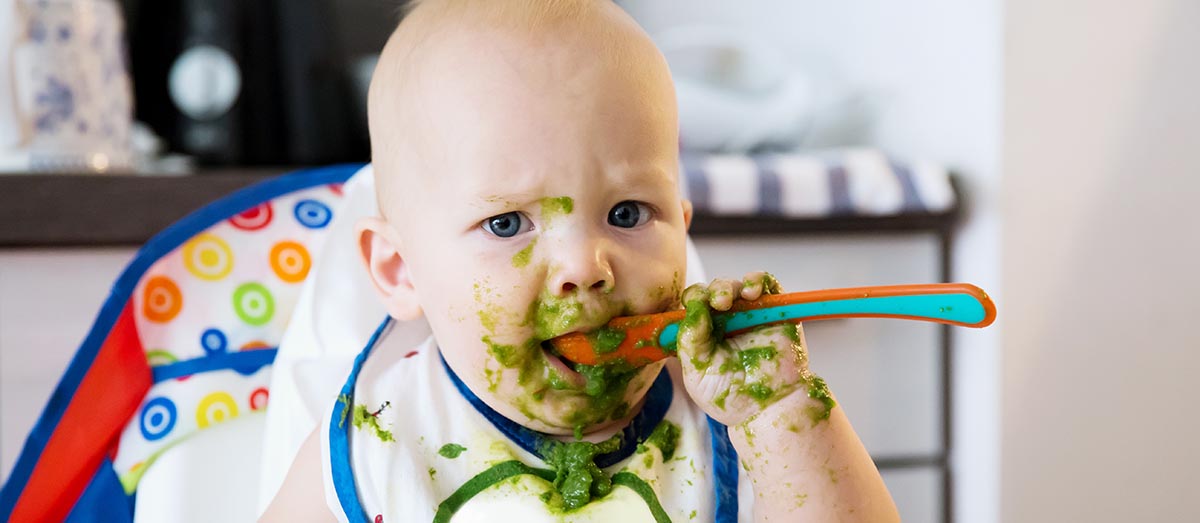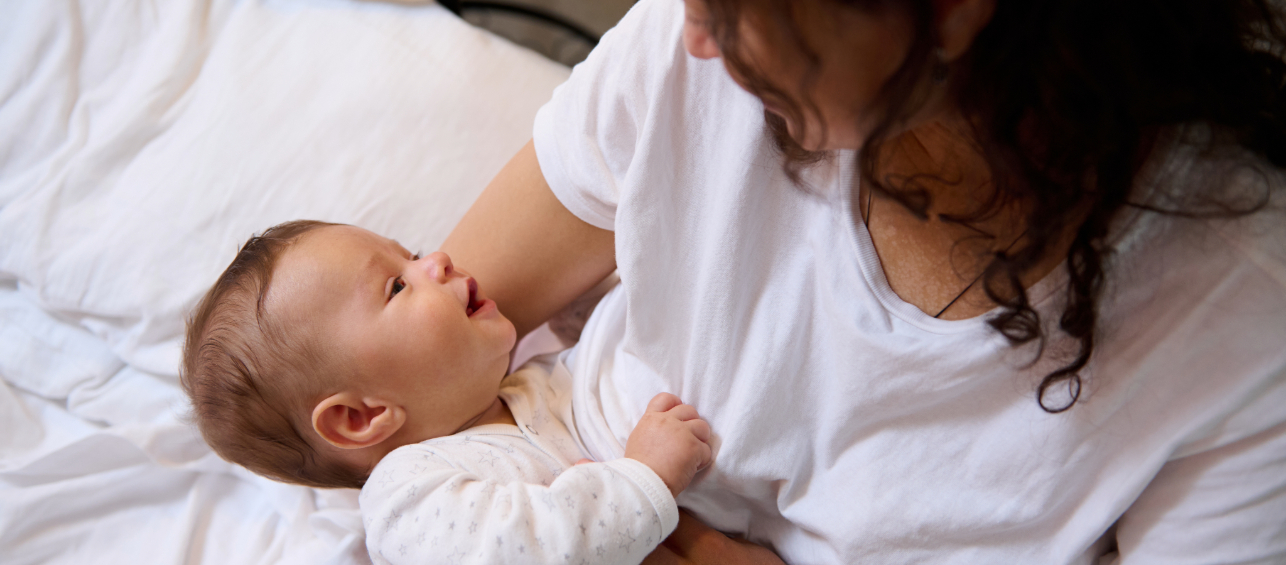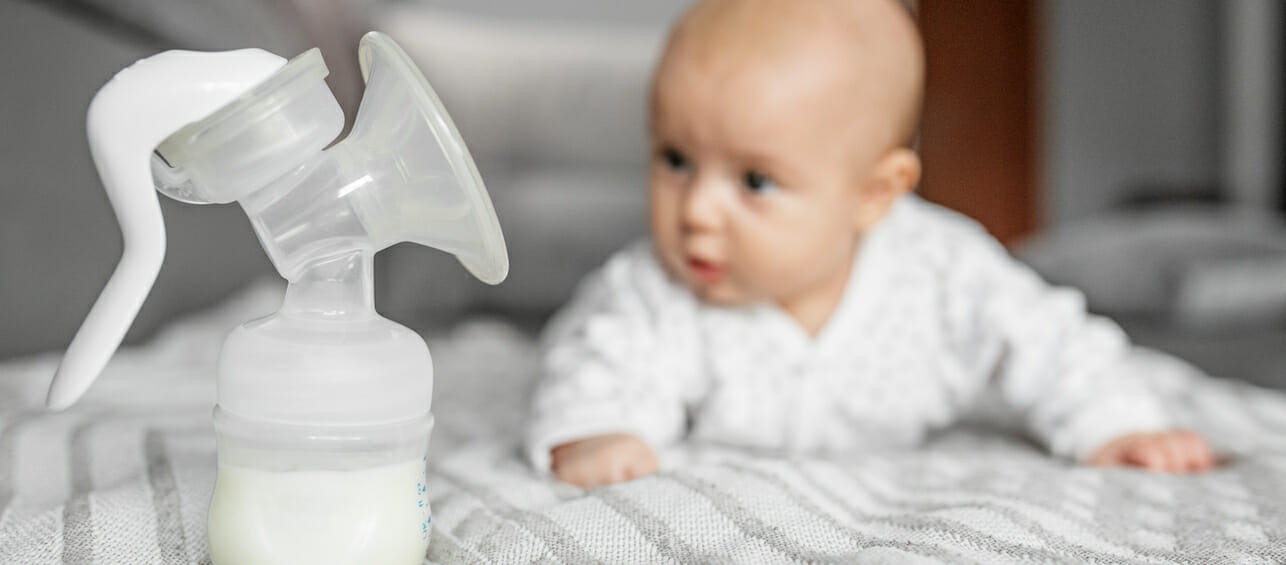Starting your baby on solid foods can be both exciting and trying. It’s fun to experience new tastes and textures with your baby. But it can also be a little stressful, especially if it isn’t going well. Eating solid foods is a skill that needs to be learned, and this takes time.
Because of this, parents naturally and understandably may turn to friends, family, books or the internet for help. One popular technique is “baby-led weaning,” which is the process of introducing solid foods to a baby and gradually reducing breast milk or formula. Baby-led weaning is a method that encourages the baby to feed herself. It recommends skipping purees and spoon-feeding and going directly to the solids that the rest of the family is eating.
As a feeding therapist in the division of Occupational and Physical Therapy at Cincinnati Children’s, I believe there are both pros and cons to this approach. There are aspects that are great, and there are some watch-outs to keep babies safe. From my perspective, there is no one right way to feed a baby. If you’d like to skip ahead to read what I recommend, go to the “Consider a Moderate Approach” section below.
Pros and Cons of Baby-Led Weaning
Pros
- It gives baby control over what he eats
Giving your baby control over what he eats may teach him to self-regulate hunger. He’ll stop when he’s full, rather than taking those last few bites his caregiver spoon-feeds him. - It helps to teach new skills, including oral and fine-motor skills
For a baby who might not be sure about a new taste or texture, it can give her control to manipulate it in her mouth and swallow it or not. It also aids in hand-eye coordination. - It allows your baby to get messy
Getting messy is okay! In fact, I recommend it. It may even help reduce the stress some babies experience when they have things on their hands. - Your baby may be less likely to become overweight
Some research suggests that a baby who learns how to self-regulate hunger will be less likely to become overweight as they get older.
Cons
- Potential safety concerns
Giving babies certain foods before they’ve developed the needed oral motor skills to eat it could lead to gagging, vomiting and potentially choking. - Potential negative mealtime experience
While gagging and coughing are both mechanisms to help prevent a baby from choking, these reflexes are both uncomfortable and scary for the baby. Learning to eat solid foods takes a lot of practice. We want babies to have a positive eating experience so that they want to keep doing it and trying new things. Mealtime should be fun! - It’s harder to pinpoint an allergic reaction
If there are allergy concerns in the family, some pediatricians may recommend introducing foods one at a time. This helps to pinpoint which food was the culprit. If many foods are given at once, it’s more difficult to identify.
Consider a Moderate Approach
I recommend to families a moderate approach to introducing solid foods to babies. Specifically, starting babies with single-item purees, but quickly transitioning to easy-to-eat table foods. Additionally, I recommend a little of both approaches – offering tastes from the spoon and allowing the baby to feed himself. So how can parents implement this? Here are a few recommendations:
- Get your doctor’s okay to start solid foods
This typically happens around six months, if the baby was full term, when they have good head and trunk control and are showing an interest in what their parents are eating. - Utilize a high chair or supportive booster at the table
- Have her eat with the rest of the family
Eating is a social and emotional experience. Make it exciting and fun! - Take turns
Help your baby feel in control by taking turns with the spoon. You feed him one bite and he feeds himself the next bite. When you decide he’s ready to try chunkier foods, I recommend avoiding choking hazards like grapes and hot dogs. Close supervision is key, no matter what you’re feeding him. - Expose your baby to as many tastes and textures as possible between 6-12 months of age
This could mean starting with purees and using a spoon. However, it’s important to not stick with purees for too long, because babies need to experience many different tastes and textures to support oral-motor skill development, as well as a diverse palate.
For most families, this can be a helpful approach. However, babies who have poor weight gain or seem hesitant to this approach may need to work with a feeding therapist to design a plan that works well for that child. Further, premature babies may need to follow their adjusted age. Talk to your baby’s doctor about it.
This approach (or any other approach, for that matter) will not work for every child and every family. In general, if feeding isn’t going well, talk to your child’s doctor about it. She may recommend a referral to a feeding therapist to help support both you and your baby. The sooner we can intervene and make feeding a positive experience, the better.
To learn more about our division of Occupational and Physical Therapy, please call 513-636-4651 or email otpt@cchmc.org.






This is the Ohio AAP statement about Baby Led Weaning:
“Baby Led Weaning” (BLW) is a term that has been around for decades and has many definitions. Most commonly
it refers to the introduction of soft finger foods when an infant demonstrates their readiness to feed themselves. Its progression follows the baby’s individual pace rather than a set month-dependent change in food type or texture.
When Does BLW Start?
Generally, BLW occurs around 6 months. There is individual variability but the baby must be able to:
• sit up with little to no support
• grab things and hold items
• accurately guide items to their mouth
False cues that occur at earlier ages sometimes prompt caregivers to feed solids early. In BLW, parents are encouraged to recognize these as false cues as listed below.
False Cues:
• Watching others eat • Waking at night
• Slow weight gain
• Lip smacking
• Not falling asleep while nursing or feeding
How is BLW Different?
• Generally, baby is self-feeding with their hands.
• No spoons or purees are used.
• Baby is served soft foods and he/she is in charge of
how much and how quickly or slowly they eat.
• First foods are not necessarily grains.
How do you start BLW?
• Baby begins by joining the family for meals.
• In the beginning. this is more about exploring foods and less about the nutrition going into the baby.
• Use small pieces of soft foods to begin with.
• Let baby feed herself as much as possible.
• Let baby decide how much to eat and how quickly.
• Offer water with solids once baby is 6 months and older.
First Food Tips:
• Vegetables should be cooked until soft – carrots, broccoli (soft enough to eat, but not too soft, so that they crumble).
Provider Notes
• Roasted peeled vegetables – potato wedges, sweet potato and carrots.
• Ripe, soft fresh fruit – pear, banana, mango, melon and avocado.
• Meat and Fish – avoid lumps, but make it easy enough for baby to pick up and chew. Typically, baby will suck on meat and spit out remainder until they are older and can chew better.
• Beans – rinse soft beans and mash them with a fork to get rid of larger lumps.
Why is BLW Considered Healthy?
• Baby led eating respects and fosters the baby’s awareness of their own hunger and satiety, which is associated with decreased obesity and better eating habits.
• Babies that have transitioned to solids with BLW have less preferences for sweet foods and a greater variety of foods they like by type and texture. This is associated with less picky eating in childhood, which is associated with better health outcomes. In addition, this may lead to greater diet variety and higher fruit and vegetable intakes later in life.
• BLW babies are more open to multiple tastings of foods.
• BLW is eating with all 5 senses, which offers excellent sensory and physical opportunities for babies.
• BLW takes the pressure off parents to get a specific volume of food into baby; therefore, parents often report enjoying it more.
What About Choking?
It is important to distinguish choking from gagging. These terms are commonly confused by parents.
• Gagging is a safety response.
• Choking is when the food is obstructing the baby’s
airway and the baby is starting to look panicked, has stopped making sounds, and may be turning blue. Encourage parents to take infant CPR classes.
Note with BLW, it is important that babies are always sitting up and not leaning when they are eating.
What About Iron or Vitamin D?
Follow standard recommendations of care for these nutrients of concern.
Baby Led Weaning
ohioaap.org/projects/PMP